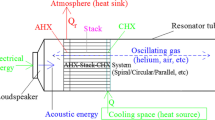Abstract
The thermoacoustic effect concerns conversion of energy between a gas and a solid in the presence of acoustic waves. Although the working principle is well understood, the optimal design of thermoacoustic devices remains a challenge. The present work aims to perform a numerical simulation of a simple standing-wave thermoacoustic device. The analysis of the flow and the prediction of the heat transfer are performed by solving the non-linear unsteady Navier–Stokes equations using the finite volume method implemented in the commercial code ANSYS-CFX. The goal of this work is to study the effect of the stack temperature gradient, on the acoustic pressure and the produced acoustic power. This stack temperature gradient generates the thermoacoustic instability in standing-wave thermoacoustic resonator. The obtained results show an increase of the acoustic pressure and the acoustic power while increasing in the stack temperature gradient. The thermodynamic cycles of the thermoacoustic device are illustrated and observed for the different stack temperature gradients.
Similar content being viewed by others
References
S.H. Tasnim, S. Mahmud, and R.A. Fraser, Effects of variation in working fluids and operating conditions on the performance of a thermoacoustic refrigerator, Inter. Commun. Heat and Mass Transfer, 2012, Vol. 39, P. 762–768.
H. Hatori, T. Biwa, and T. Yazaki, How to build a loaded thermoacoustic engine, J. Appl. Phys., 2012, Vol. 111, No. 7, P. 074905–073710.
S. Backhaus, E. Tward, and M. Petach, Traveling-wave thermoacoustic electric generator, Appl. Phys. Lett., 2004, Vol. 85, P. 1085–1087.
G.W. Swift and J.J. Wollan, Thermoacoustics for liquefaction of natural gas, GasTIPS. 2002, Vol. 8, No. 4, P. 21–26.
N. Cao, J. Olson, G.W. Swift, and S. Chen, Energy flux density in a thermoacoustic couple, J. Acoust. Soc. Am., 1996, Vol. 99, No. 6, P. 3456–3464.
A.S. Worlikar and O.M. Knio, Numerical simulation of thermoacoustic refrigerators, J. Comput. Phys., 1996, Vol. 127, P. 424–451.
E. Besnoin and O.M. Knio, Numerical study of thermoacoustic heat exchangers in the thin plate limit, Numer. Heat Transfer, Part A: Applications, 2001, Vol. 40, P. 445–471.
E. Besnoin, Numerical study of thermoacoustic heat exchangers. PhD thesis, Johns Hopkins University, Baltimore, Maryland, 2001.
D. Marx and P. Blanc-Benon, Numerical simulation of stack-heat exchangers coupling in a thermoacoustic refrigerator, AIAA J., 2004, Vol. 42, P. 1338–1347.
L.A.J. Nijeholt, M.E.H. Tijani, and S. Spoelstra, Simulation of a traveling wave thermoacoustic engine using computational fluid dynamics, J. Acoust. Soc. Am., 2005, Vol. 118, No. 4, P. 2265–2270.
G. Yu, W. Dai, and E. Luo, CFD simulation of a 300 Hz thermoacoustic standing wave engine, Cryogenics, 2010, Vol. 50, No. 9, P. 615–622.
F. Zink, J. Vipperman, and L. Schaefer, CFD simulation of a thermoacoustic engine with coiled resonator, Inter. Commun. Heat and Mass Transfer, 2010, Vol. 37, No. 3, P. 226–229.
F. Zink, J. Vipperman, and L. Schaefer, CFD simulation of thermoacoustic cooling, Int. J. Heat and Mass Transfer, 2010, Vol. 53, No. 19-20, P. 3940–3946.
O. Hireche, C. Weisman, D. Baltean-Carlés, P. Le Quéré, and L. Bauwens, Low mach number analysis of idealized thermoacoustic engines with numerical solution, J. Acoust. Soc. Am., 2010, Vol. 128, No. 6, P. 3438–3448.
G. Swift, Thermoacoustics, Springer Handbook of Acoustics, Springer, New York, 2007, P. 239–255.
Author information
Authors and Affiliations
Corresponding author
Rights and permissions
About this article
Cite this article
Dar Ramdane, M., Khorsi, A. Numerical investigation of a standing-wave thermoacoustic device. Thermophys. Aeromech. 22, 313–318 (2015). https://doi.org/10.1134/S0869864315030051
Received:
Revised:
Published:
Issue Date:
DOI: https://doi.org/10.1134/S0869864315030051




